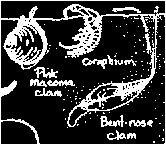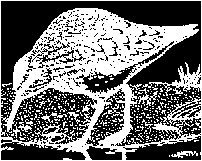| |
|
What are Shorebirds?
Feeding and Habitat 
Shorebirds depend upon wetlands for food. Wetlands include marshes, river deltas, mud flats, tundra, and intertidal areas. While wintering and migrating, shorebirds feed upon tiny clams, snails, sand fleas, and worms in the mud and sand near the water's edge. Bill size and shape, like coloration, is an adaptation to the shorebird's environment. Shorebirds with short bills probe for animals that live very near the surface. Those with longer bills can reach animals buried deeper in the mud. Millions of shorebirds breed and raise their chicks each summer in the Arctic. During this short breeding season in the northern tundra, they feed on insects, grubs, and worms that they capture in the vegetation.
 When humans fill wetlands with gravel to construct parking lots and buildings, shorebirds cannot find food. Many shorebirds return instinctively to the same feeding areas every time they migrate. Thousands, hundreds of thousands, and even millions of shorebirds might be found together in one place during migration. If the wetlands to which they return each year by instinct are destroyed, they do not have the ability to look somewhere else. Even if they did, where would they find another wetland when all the wetlands have been filled? Where will the shorebirds go? What will the shorebirds eat?
When humans fill wetlands with gravel to construct parking lots and buildings, shorebirds cannot find food. Many shorebirds return instinctively to the same feeding areas every time they migrate. Thousands, hundreds of thousands, and even millions of shorebirds might be found together in one place during migration. If the wetlands to which they return each year by instinct are destroyed, they do not have the ability to look somewhere else. Even if they did, where would they find another wetland when all the wetlands have been filled? Where will the shorebirds go? What will the shorebirds eat?
|
|
|
|

